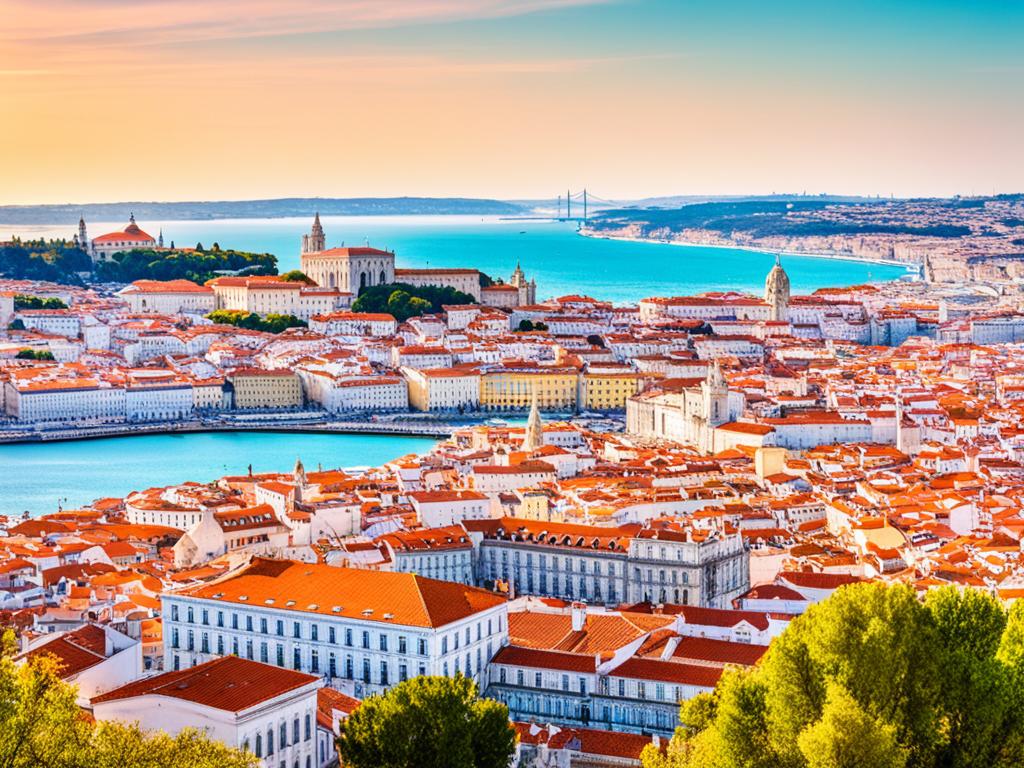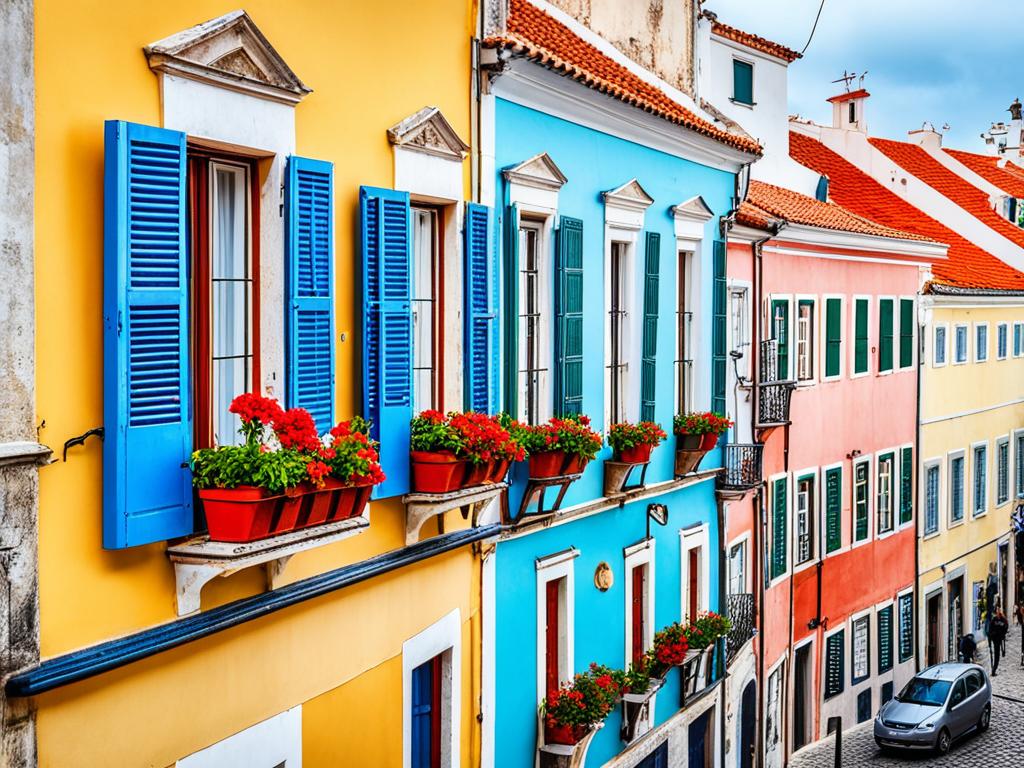With the rise of the sun over the Tagus River, I feel excited. Lisbon, the capital of Portugal, sits waiting for me to explore. It’s known for its rich history, beautiful buildings, and lively culture.
This city mixes the past with the present in a perfect harmony. Every corner you turn, from the traditional Alfama neighborhood to the buzzing Bairro Alto, offers a unique experience. It’s a place that will stay with you forever.
Walking around, the scent of Pastéis de Nata fills the air. These are Lisbon’s famous egg tarts. And the music of Fado plays everywhere, telling stories of the city’s soul.
Prepare to be amazed by Lisbon’s buildings, like the Jerónimos Monastery. It’s a UNESCO World Heritage Site. Everywhere you go, you’ll see how the past and present mix beautifully. This city promises a memorable journey.
Key Takeaways
- Lisbon, the captivating capital of Portugal, blends rich history, stunning architecture, delectable cuisine, and vibrant culture.
- Explore the charming cobblestone streets of the Alfama neighborhood and the lively nightlife of Bairro Alto.
- Indulge in the iconic Pastéis de Nata, a beloved symbol of Lisbon’s gastronomic heritage.
- Immerse yourself in the soulful melodies of Fado music, deeply rooted in the city’s cultural identity.
- Discover the architectural wonders of Lisbon, including the Jerónimos Monastery, a UNESCO World Heritage Site.
Lisbon: A Captivating Capital on the Iberian Peninsula
Lisbon sits by the grand Tagus River, making it a stunning spot on the Iberian Peninsula. It’s the beautiful capital of Portugal with a calm Mediterranean climate. This means it offers warm summers and mild winters, perfect for year-round visits.
Geographical Location and Climate
Lisbon is strategically located on the west coast of the Iberian Peninsula. It nears the Atlantic Ocean and stands at the Tagus River’s mouth. This spot has made Lisbon famous for maritime adventures and trade over the years. With sunny days and moderate temperatures, it’s no wonder Lisbon feels welcoming and comfortable for all who visit.
Multicultural Influences and Diversity
Lisbon has a history deeply tied to maritime travel, bringing in a rich and diverse cultural heritage. It has seen the influence of the Romans, Visigoths, Moors, and of course, the Portuguese explorers. Their mark is visible in Lisbon’s varied architecture, food, and arts, creating a lively cityscape. This mix of cultures attracts people from all over the globe.

| Landmark | Significance |
|---|---|
| Jerónimos Monastery | A UNESCO World Heritage Site, this stunning example of Manueline architecture showcases Lisbon’s maritime heritage. |
| Pastéis de Nata | The iconic Portuguese egg tart, a beloved symbol of Lisbon’s rich culinary traditions. |
| Fado Music | A soulful and emotive musical genre that is deeply intertwined with the cultural identity of Lisbon. |
Architectural Wonders of Lisbon
Lisbon’s architectural mix tells a colorful story rich in history and culture. The Jerónimos Monastery is a key player in this, showing off the Manueline style. It’s a unique late Gothic architecture unique to Portugal and a UNESCO World Heritage Site.
Jerónimos Monastery: A UNESCO World Heritage Site
The Jerónimos Monastery celebrates Portugal’s golden age of sea exploration. It was built in the early 16th century by King Manuel I. This structure is filled with detailed stone carvings that nod to the country’s maritime legacy.
Inside, visitors are treated to richly decorated cloisters, a striking church, and peaceful gardens. It’s a must-see place for anyone visiting Lisbon.
Bairro Alto: Charming Neighborhood with Vibrant Nightlife
Bairro Alto is a stark contrast to the Monastery, brimming with modern life. It’s known for its colorful buildings, small streets, and lively nights. At dusk, the neighborhood fills with the sounds of Fado, a touching Portuguese music, and people enjoying the vibrant scene.
Baixa: The Historic Heart of Lisbon
Baixa, the city heart, rose again after the 1755 earthquake. It’s now home to elegant neoclassical buildings. The area highlights Lisbon’s historic charm, with the Praça do Comércio at its center, offering views of the Tagus River.
Culinary Delights of Lisbon
Lisbon mixes old Portuguese tastes with new food trends. This blend is seen best in the city’s favorite dish, the Pastéis de Nata. These are Portuguese egg tarts.
Pastéis de Nata: The Iconic Portuguese Egg Tart
These pastries are famous and show Lisbon’s cultural mix. They began at the Jerónimos Monastery. When you’re in Lisbon, you must try them. They are best eaten in the Baixa district or the Bairro Alto area.

The mix of a flaky crust and creamy filling is a hit. Enjoy them with some strong coffee in Lisbon. This combo takes you right into Lisbon’s rich culinary world.
Lisbon: A City Steeped in History and Culture
Lisbon is full of history and culture. Everywhere you look, you see the city’s past and present. The city is alive with traditions. From the old Alfama neighborhood to the modern Bairro Alto, Lisbon’s spirit shines.
Alfama: The Oldest Neighborhood in Lisbon
The Alfama neighborhood is like stepping into the past. Its streets are made of cobblestones. And the buildings are from long ago. Walking here, you can feel Portugal’s history all around you.
Equally important in Lisbon is
Fado Music: The Soul of Portuguese Culture
Fado music tells powerful stories. It’s a key part of the city’s soul. Fado’s sad tunes and meaningful lyrics touch people’s hearts. You can listen to Fado by visiting small places in Alfama. There, its deep history and feelings are everywhere.

Visiting Alfama and listening to Fado makes Lisbon unforgettable. The city thrives by keeping old customs but also being modern. As Portugal’s capital, it welcomes you with open arms. It’s a place of rich history, great art, and infectious energy. Lisbon truly is a jewel of the Iberian Peninsula.
Tagus River: The Lifeblood of Lisbon
The Tagus River flows through Lisbon, being the city’s heart for centuries. This huge waterway has influenced the city’s history, economy, and culture. It’s been a key path for transportation and a muse for artists and poets.
The river contributed greatly to Lisbon’s growth. It helped with trade and commerce, linking the city to the world. The beautiful banks inspired many creative minds, adding to the river’s legacy.
Today, exploring Lisbon by cruising the Tagus River or walking its promenades is a must. It offers views of Jerónimos Monastery and the stunning Alfama and Bairro Alto areas. The river adds to Lisbon’s unique culture with every flow.




